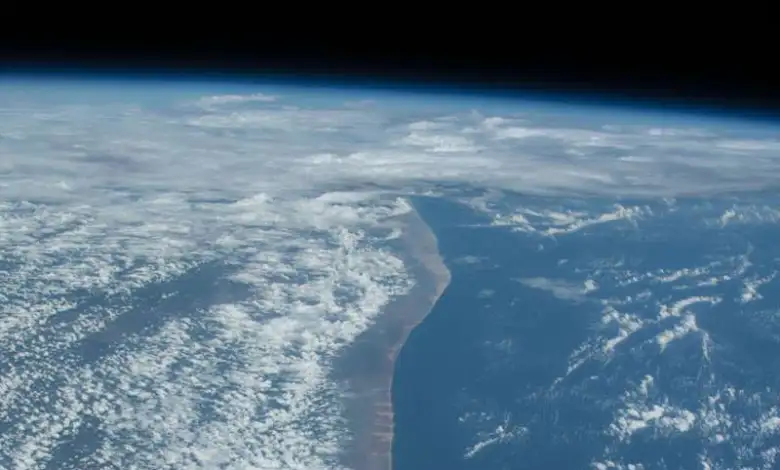Ongoing climate change from greenhouse gas emissions is often discussed in terms of average global warming, for example, the landmark Paris Agreement seeks to limit global warming to 1.5°C, compared to pre-industrial levels.
The extent of future warming will not be the same across the planet. One of the most obvious regional differences in climate change is that the land is warming faster than the sea. This “terrestrial amplification” of future warming has real-world implications for understanding and dealing with climate change.
Geochemical records of climate
A new paper examining terrestrial amplification focuses on how geochemical records of past climate on land and at the sea surface allow scientists to better predict how much more land than oceans will warm — and also become drier — due to current and future greenhouse gas emissions.
“One of the reasons why understanding terrestrial amplification is important is that with future global warming, the magnitude of warming that the planet will experience will not be the same,” says Alan Seltzer, associate scientist in the Department of Marine Chemistry and Geochemistry at the Woodszell Institution of Oceanography and lead author of the paper. Everywhere”, “adding a solid foundation to climate model simulations, rooted in observations of past climate and fundamental physics, can tell us about regional differences in ongoing and future warming.”
Seltzer notes that terrestrial amplification is analogous to “polar amplification,” a climate model prediction that higher latitudes will warm more than lower latitudes.
Increased warming on Earth’s surfaces is evident
Although recent observational records are noisy due to large year-to-year changes driven by other parts of the climate system, predictions of increased warming at Earth’s surfaces are now evident in climate data since the 1980s.
The drivers of this terrestrial amplification have been linked to changes in moisture over land and sea, through a theory developed by climatologists over the past decade. This new study, published Wednesday in the journal Science Advances, “uses paleoclimate data for the first time to assess the theory of how land and sea surface might be affected by future warming.”
As Seltzer says, “The research gives us more certainty in the way models predict regional changes in future global warming.”
Terrestrial amplification during the Ice Age
The paper looks at terrestrial amplification during the last ice age maximum – which occurred about 20,000 years ago – at low latitudes, defined as 30⁰S-30⁰N. At these latitudes, the authors say, the theoretical basis for TA is most applicable.
The authors relied on new sets of paleoclimate records on land and from the sea surface to estimate the magnitude of TA in the LGM, for comparison to climate model simulations and theoretical projections.
Efforts to better understand how cold the continents are in the LGM are an ongoing focus of Seltzer’s research at WHOI, and this new paper builds on a recent study that used insights from dissolved gases trapped in ancient groundwater as a thermometer for Earth’s past surface.
Double changes in wet static energy
The authors extend a thermodynamic theory of terrestrial amplification that is based on dual changes in wet static energy (potential energy represented by temperature, moisture content, and altitude of a fraction of the air) between land and sea.
When the sea level was 120 meters lower than it is today due to the growth of large ice sheets on the ground, the sea surface was slightly warmer and wetter than it would have been without a change in sea level.
By taking this effect into account and drawing on paleoclimate records, the authors were able to directly compare past terrestrial amplification with future predictions.
The paper notes that while the mechanisms behind TA are well understood that they arise from fundamental thermodynamic differences between moist air over the ocean and dry air over land, a number of factors—natural variability, observational limitations, thermal delays, Forcings other than carbon dioxide have previously prevented an accurate estimate of TA from 20th century warming.
As stated in the paper, “Narrowing down terrestrial amplification will aid in future predictions of climate change at low latitudes, with its association with both heat stress and water availability.”
A step forward for climate science
The paper is “a step forward for climate science,” says co-author Pierre-Henri Ballard, who will be important for other scientific fields and the general public. at low to mid-latitudes at any time scale—as 40% greater than over the ocean. This result is important because while most archives of paleoclimate are found in the ocean, the present and future of humanity critically depends on our knowledge of continental climates.”
The research is important “because it helps us understand Earth’s past climate record and how it relates to our models and projections for the future,” says co-author Stephen Sherwood. “The paper should clear up any misconceptions that land and oceans warm or cool at the same rate in different climates — and we know otherwise.” We must use this knowledge, and the consequences for the future are that the Earth’s continents will continue to warm faster than the oceans as global warming continues, until we hope to reach net zero and stop it. ”












